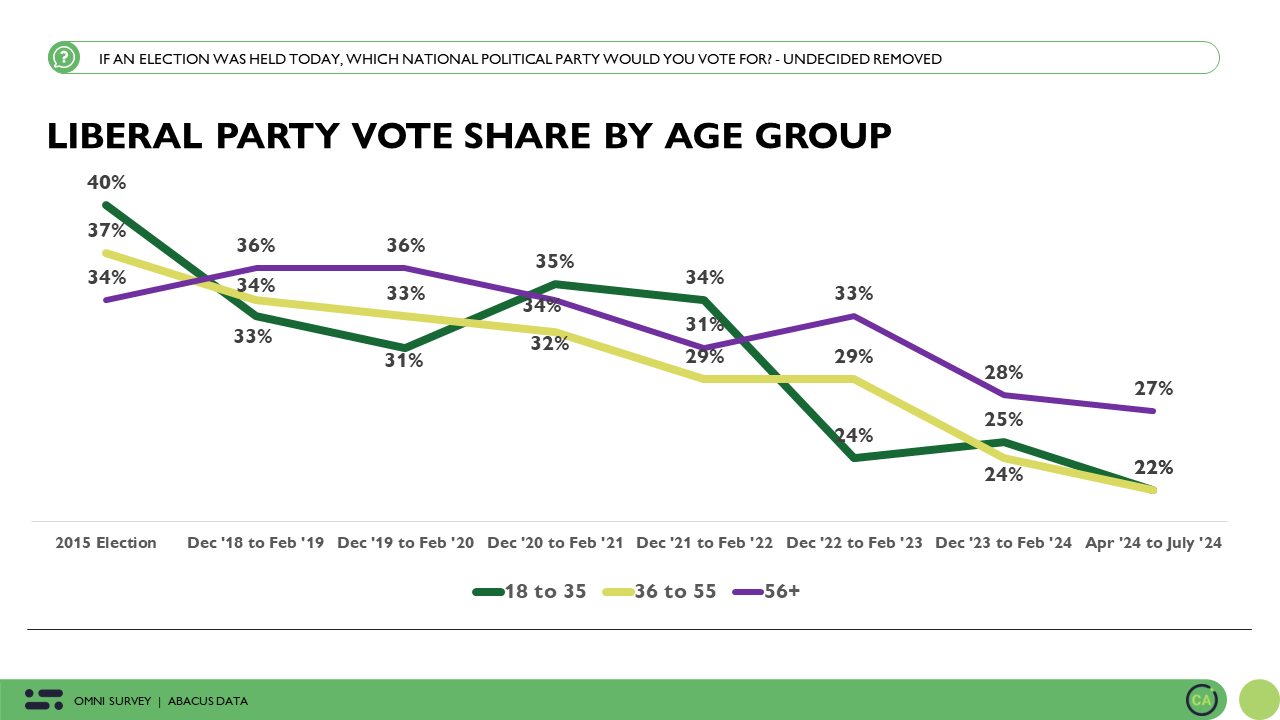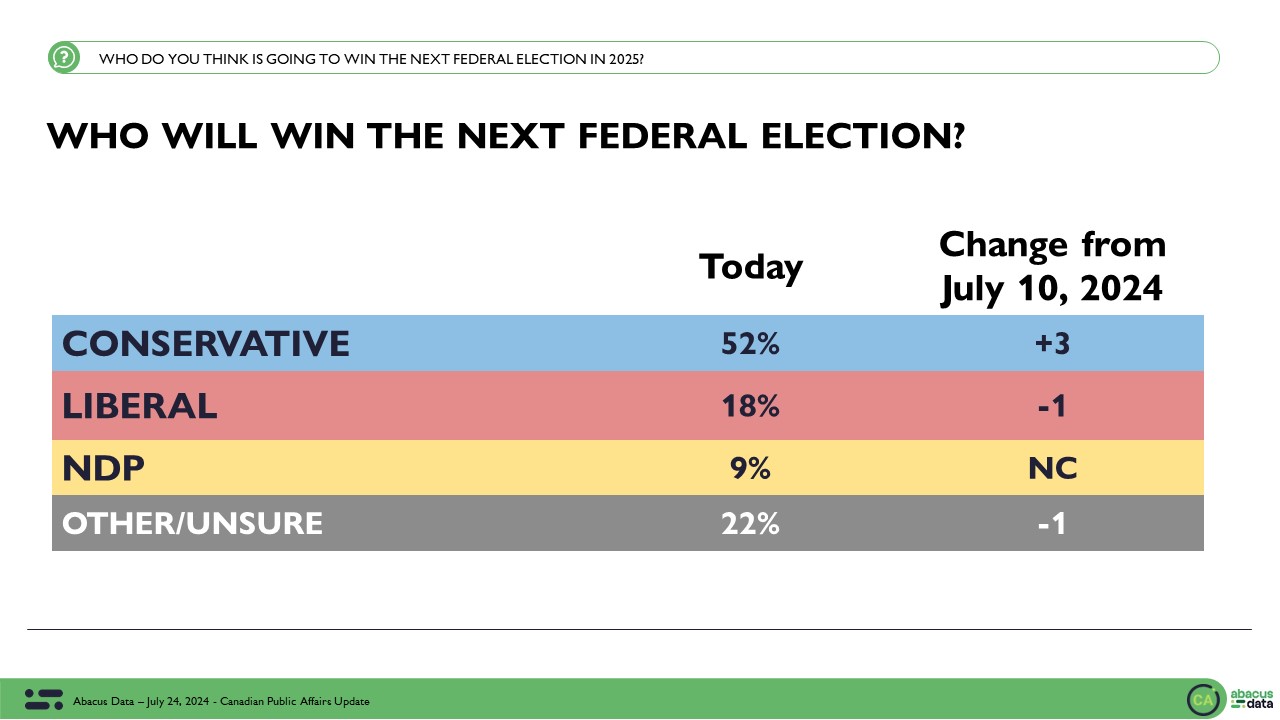Election Poll: Tight race with two weeks to go
October 7, 2019
Our latest nationwide survey measured the federal election trends.
Here’s what we found:
LIBERALS HAVE SLIGHT EDGE – TWO WAVES IN A ROW.
If an election were held at the time of the survey, the Liberals (35%) would capture slightly more support than the Conservatives (33%), followed by the NDP at 16%, the Greens at 8%, and the BQ at 5% (19% in Quebec). Maxime Bernier’s People’s Party registers just 1% support nationally.

The regional races tell a clearer story of where the race stands. In Alberta and Saskatchewan, the Conservative Party has a 37-point lead, an advantage which has widened from 30 points in August. In the rest of the country, the Liberals have consistently led the Conservatives this year, and since August, a 5-point advantage has widened to 9 points.


In BC, we see a 5-point lead for the Liberals, in Ontario, a closer 2-point race. The Liberals have a 27-point lead in Atlantic Canada and a 21-point lead in Quebec.
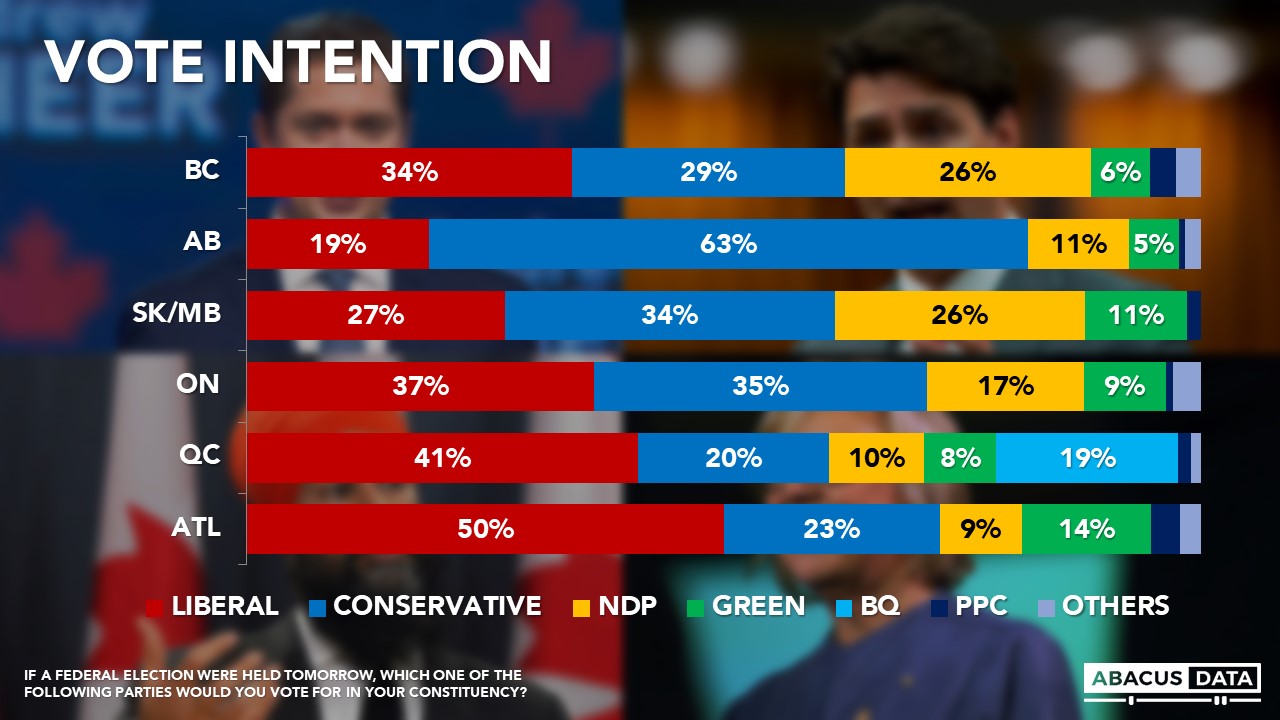
There are signs that the Liberals are seeing support rise among women, and also indications that support for the Green Party is waning.

Conservatives continue to have a massive lead among voters who self identify as right of centre, including a 49-point lead among “centre-right” voters. Among centre-left voters, the Liberals have a 33-point lead over the NDP, 3 points more than a few weeks ago.
Perhaps the most encouraging sign for the Liberals is this: among the roughly half (49%) of voters who identify as being in the centre of the political spectrum, the Liberals now lead the Conservatives by 6 (35% to 29%) with the NDP in third at 16%.
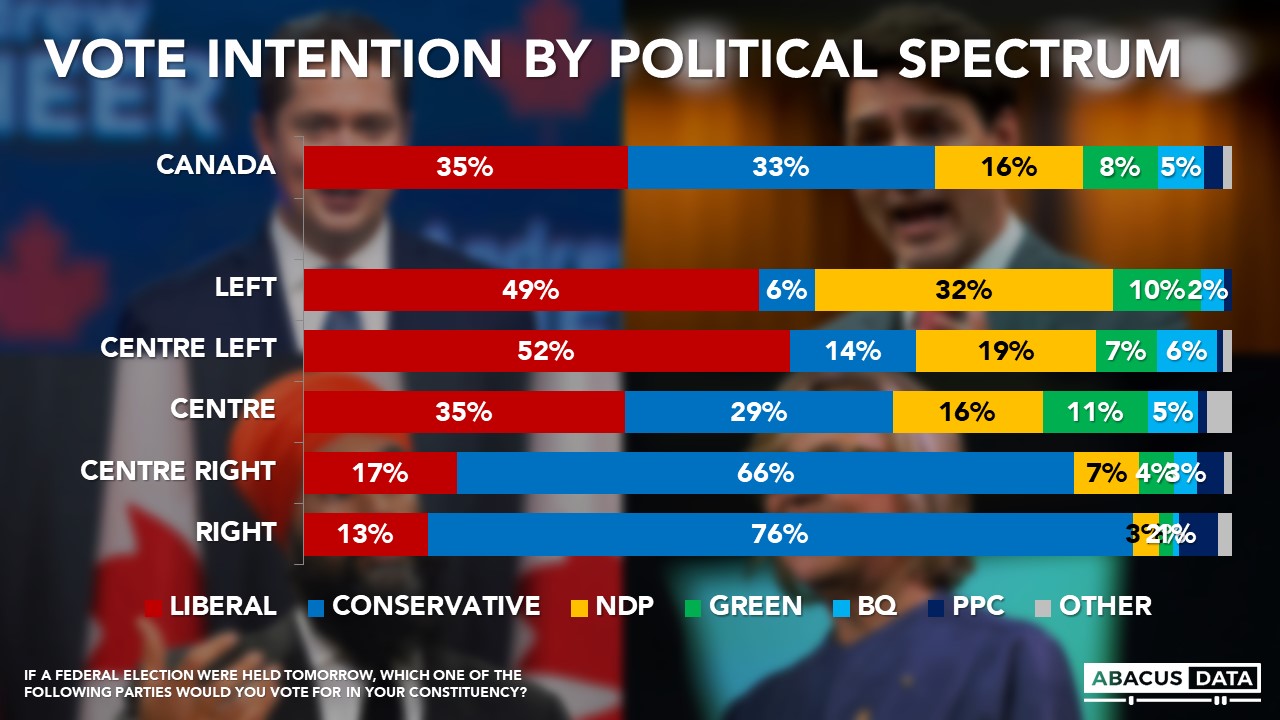
LEADER POPULARITY: SCHEER NEGATIVES UP AGAIN; SINGH WITH BEST NET FAVOURABLES
Mr. Trudeau has 35% positive and 47% negative opinion across the country. Those numbers suggest his positives have regained 4 points from the drop after the blackface story emerged.
Andrew Scheer has 33% positive and 44% negative opinion nationally. This represents a further growth of negative opinion towards the Conservative leader.
Jagmeet Singh is 32% positive and 25% negative, relatively steady from our last wave. Mr. Singh now has the most positive net impression of all the federal leaders at +7.
Elizabeth May has 26% positive and 22% negative opinion. These numbers are weaker than we had been seeing for the Green Party leader earlier in the year.
IN A HEAD-TO-HEAD, MORE PREFER A LIBERAL GOVERNMENT OVER CONSERVATIVE ONE, ESPECIALLY AMONG ACCESSIBLE NDP AND GREEN VOTERS.
To assess what might happen if voters consolidate around the Liberals or Conservatives as election day nears, we asked respondents whether they would prefer to see a Liberal or Conservative government. Overall, 54% would prefer the Liberals to 46% for the Conservatives.
Among NDP, BQ, and Green supporters, 60% or more would prefer a Trudeau government to a Scheer one.
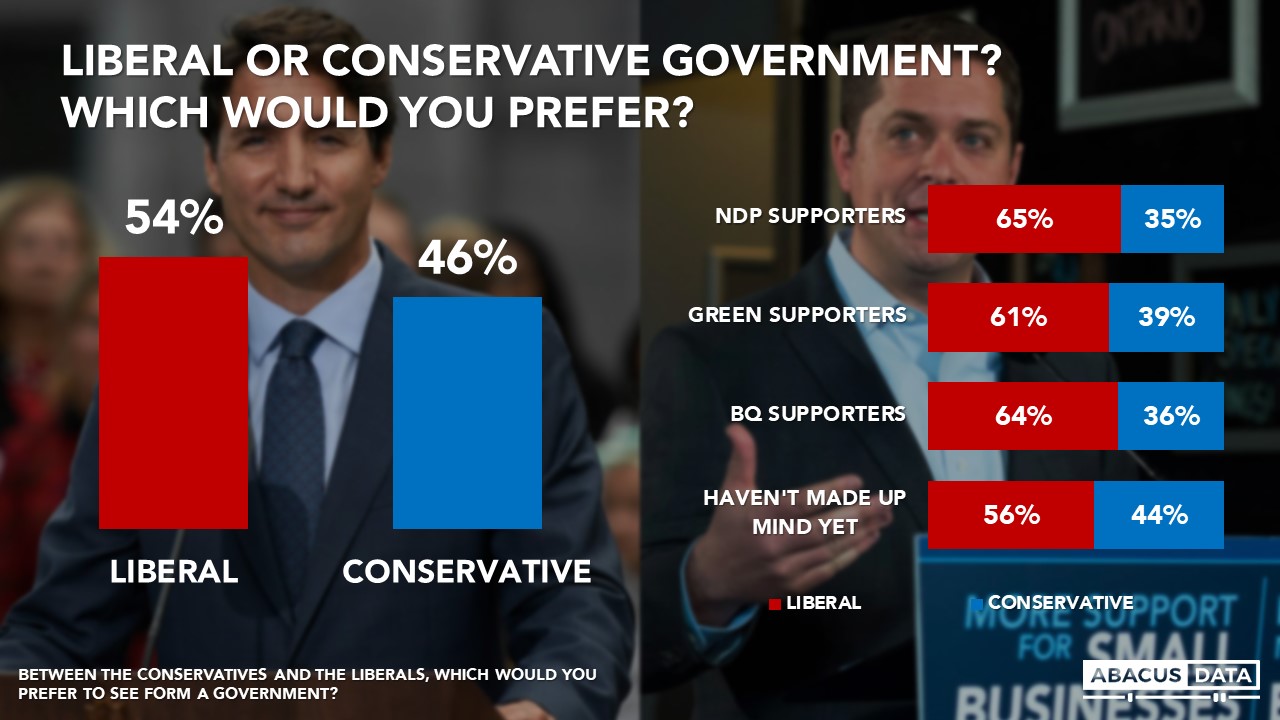
MORE HAVE MADE UP THEIR MIND
As of Saturday, 69% of respondents say they have made up their mind about how they are going to vote in the election, up 6-points from a few weeks ago. 31% say they haven’t yet made up their minds.
Those aged 60 and over are the most likely to say they have made up with mind (77%), while those under 30 are the least likely (64%). Women are also less likely to have firmed up their vote choice than men (66% vs. 73%).
18% of Canadians are following the campaign very closely, unchanged from September 23. There’s been a 4-point increase in those following the campaign pretty closely (to 40%), while 43% say they are following the campaign a little bit or not at all.
UPSHOT
According to Bruce Anderson: “Since our last wave, another 6% of voters say they have made up their mind about how they are going to vote, bringing the total who say their mind is made up to 69%. The recent movement has tended to be more beneficial for the Liberals outside Alberta and beneficial for the Conservatives in Alberta – underscoring a polarized debate around climate, carbon and related issues.
The movement for the Green Party may signal a critical moment for Elizabeth May in Monday’s debate – her party has struggled when issues other than climate are in focus, and many climate concerned voters are concerned with avoiding a Conservative victory.
The Conservative campaign is not making gains outside its base level of support. Part of this seems to be a reflection of how people are reacting to Andrew Scheer, but it also seems that the Conservatives have tended to stay close to the policy positions favoured by the base, rather than try to reach out to hesitant urban, female and younger voters. If anything those voters may have found reasons for their hesitancy to be reinforced by the Conservative campaign so far.
For Mr. Trudeau and the Liberals, positive interest in the BQ and Jagmeet Singh are signals that they must concentrate not only on highlighting differences with the Conservatives.”
According to David Coletto: “With two weeks to go the race remains close, and we continue to see little movement in vote intentions. But beneath the surface, we see some shifts that might ultimately lead to some changes in how people vote.
Impressions of Mr. Trudeau seem to have rebounded a little from the impact of the blackface photos. Mr. Scheer’s negatives continue to rise as the campaign progresses. His negatives are now only 3-points lower than Mr. Trudeau, a gap that stood at 7-points when the campaign began.
Mr. Singh’s numbers have improved markedly throughout the campaign. Today, 1 in 3 have a positive impression of the NDP leader, a 7-point increase from a few weeks ago and the highest we have ever captured for Mr. Singh in our tracking.
It’s a cliché to say that today’s debate could be decisive for the campaign. But given that 30% of the electorate is still up for grabs, the race is so close, and many haven’t yet tuned in, it’s hard not to feel that it will matter.”
METHODOLOGY
Our survey was conducted online with 1,556 Canadians aged 18 and over from October 3 to 5, 2019. A random sample of panellists was invited to complete the survey from a set of partner panels based on the Lucid exchange platform. These partners are double opt-in survey panels, blended to manage out potential skews in the data from a single source.
The margin of error for a comparable probability-based random sample of the same size is +/- 2%, 19 times out of 20. The data were weighted according to census data to ensure that the sample matched Canada’s population according to age, gender, educational attainment, and region. Totals may not add up to 100 due to rounding.
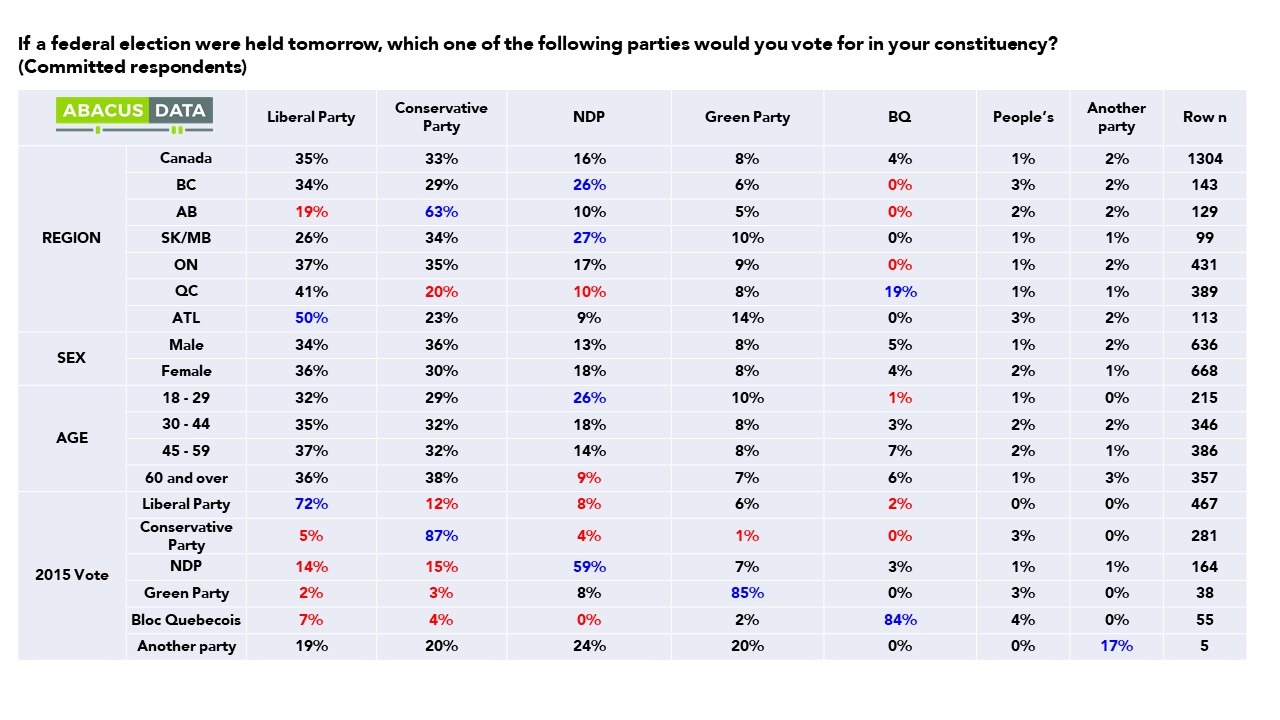
ABOUT ABACUS DATA
We are the only research and strategy firm that helps organizations respond to the disruptive risks and opportunities in a world where demographics and technology are changing more quickly than ever.
We are an innovative, fast-growing public opinion and marketing research consultancy. We use the latest technology, sound science, and deep experience to generate top-flight research-based advice to our clients. We offer global research capacity with a strong focus on customer service, attention to detail and exceptional value.
Contact us with any questions.
Find out more about how we can help your organization by downloading our corporate profile and service offering.



